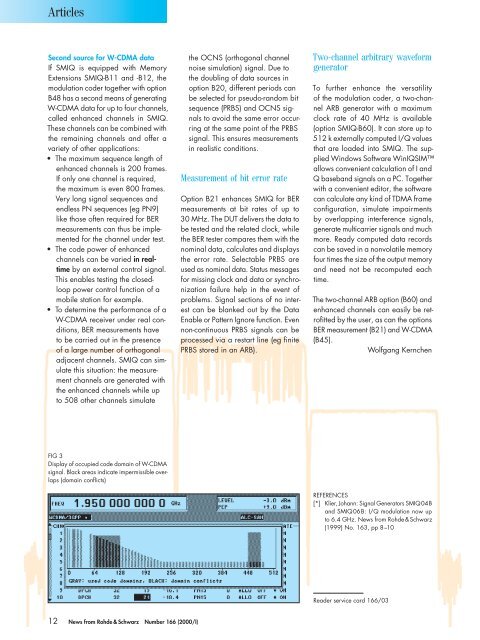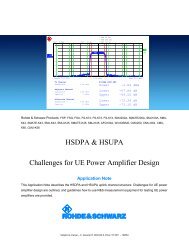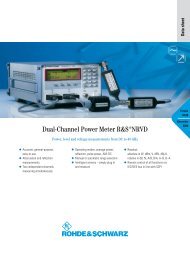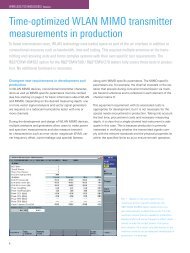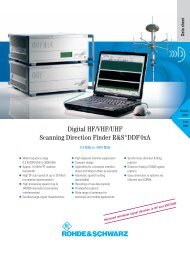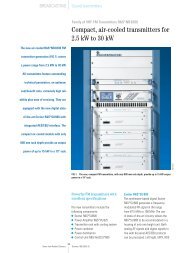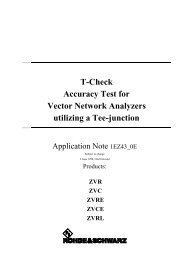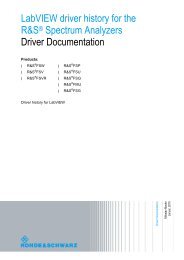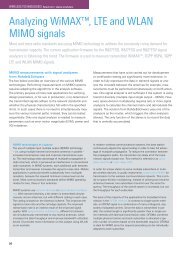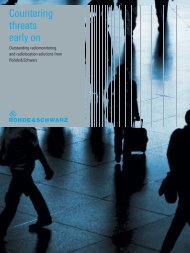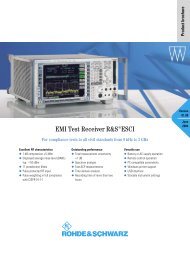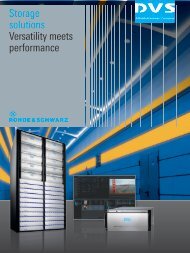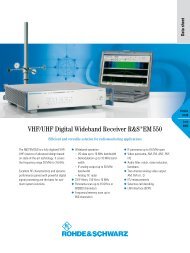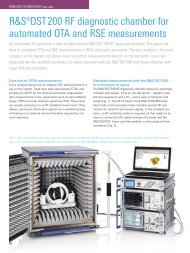English - Rohde & Schwarz
English - Rohde & Schwarz
English - Rohde & Schwarz
You also want an ePaper? Increase the reach of your titles
YUMPU automatically turns print PDFs into web optimized ePapers that Google loves.
Articles<br />
Second source for W-CDMA data<br />
If SMIQ is equipped with Memory<br />
Extensions SMIQ-B11 and -B12, the<br />
modulation coder together with option<br />
B48 has a second means of generating<br />
W-CDMA data for up to four channels,<br />
called enhanced channels in SMIQ.<br />
These channels can be combined with<br />
the remaining channels and offer a<br />
variety of other applications:<br />
• The maximum sequence length of<br />
enhanced channels is 200 frames.<br />
If only one channel is required,<br />
the maximum is even 800 frames.<br />
Very long signal sequences and<br />
endless PN sequences (eg PN9)<br />
like those often required for BER<br />
measurements can thus be implemented<br />
for the channel under test.<br />
• The code power of enhanced<br />
channels can be varied in realtime<br />
by an external control signal.<br />
This enables testing the closedloop<br />
power control function of a<br />
mobile station for example.<br />
• To determine the performance of a<br />
W-CDMA receiver under real conditions,<br />
BER measurements have<br />
to be carried out in the presence<br />
of a large number of orthogonal<br />
adjacent channels. SMIQ can simulate<br />
this situation: the measurement<br />
channels are generated with<br />
the enhanced channels while up<br />
to 508 other channels simulate<br />
FIG 3<br />
Display of occupied code domain of W-CDMA<br />
signal. Black areas indicate impermissible overlaps<br />
(domain confl icts)<br />
12 News from <strong>Rohde</strong> & <strong>Schwarz</strong> Number 166 (2000/I)<br />
the OCNS (orthogonal channel<br />
noise simulation) signal. Due to<br />
the doubling of data sources in<br />
option B20, different periods can<br />
be selected for pseudo-random bit<br />
sequence (PRBS) and OCNS signals<br />
to avoid the same error occurring<br />
at the same point of the PRBS<br />
signal. This ensures measurements<br />
in realistic conditions.<br />
Measurement of bit error rate<br />
Option B21 enhances SMIQ for BER<br />
measurements at bit rates of up to<br />
30 MHz. The DUT delivers the data to<br />
be tested and the related clock, while<br />
the BER tester compares them with the<br />
nominal data, calculates and displays<br />
the error rate. Selectable PRBS are<br />
used as nominal data. Status messages<br />
for missing clock and data or synchronization<br />
failure help in the event of<br />
problems. Signal sections of no interest<br />
can be blanked out by the Data<br />
Enable or Pattern Ignore function. Even<br />
non-continuous PRBS signals can be<br />
processed via a restart line (eg fi nite<br />
PRBS stored in an ARB).<br />
Two-channel arbitrary waveform<br />
generator<br />
To further enhance the versatility<br />
of the modulation coder, a two-channel<br />
ARB generator with a maximum<br />
clock rate of 40 MHz is available<br />
(option SMIQ-B60). It can store up to<br />
512 k externally computed I/Q values<br />
that are loaded into SMIQ. The supplied<br />
Windows Software WinIQSIM<br />
allows convenient calculation of I and<br />
Q baseband signals on a PC. Together<br />
with a convenient editor, the software<br />
can calculate any kind of TDMA frame<br />
confi guration, simulate impairments<br />
by overlapping interference signals,<br />
generate multicarrier signals and much<br />
more. Ready computed data records<br />
can be saved in a nonvolatile memory<br />
four times the size of the output memory<br />
and need not be recomputed each<br />
time.<br />
The two-channel ARB option (B60) and<br />
enhanced channels can easily be retrofi<br />
tted by the user, as can the options<br />
BER measurement (B21) and W-CDMA<br />
(B45).<br />
Wolfgang Kernchen<br />
REFERENCES<br />
[*] Klier, Johann: Signal Generators SMIQ04B<br />
and SMIQ06B: I/Q modulation now up<br />
to 6.4 GHz. News from <strong>Rohde</strong> & <strong>Schwarz</strong><br />
(1999) No. 163, pp 8–10<br />
Reader service card 166/03


